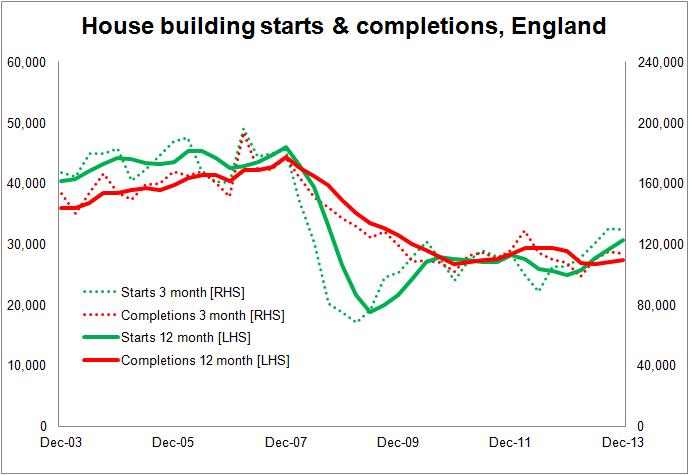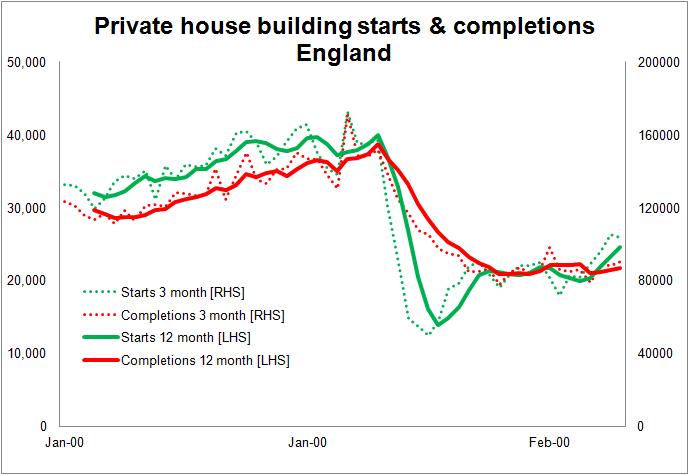Is 2014 the year when house building takes off?
There are some interesting readings to be taken from the latest house building statistics for England.
Starts eased slightly in the fourth quarter, but are still consistent with growth and last year saw 23% more than in 2012 and 10% more than in 2011.
Completions look to be perking up, despite remaining at a sadly low level. That said across the year they were 5% down on a year ago and 3% down on 2011.
We’ll look into these in a bit more detail later.
 But for now given a quick look the statistics support the widely held view that the number of homes being built is on the rise.
But for now given a quick look the statistics support the widely held view that the number of homes being built is on the rise.
It’s always a comfort when stats do that.
What is not a comfort is misuse of statistics by politicians, intentionally or otherwise.
Try as I may I can’t make these latest stats fit with the statement made by the communities secretary Eric Pickles:
“Last year we built the most homes since 2007, and even the appalling weather conditions this winter have not stopped our hardy builders from getting the job done.”
Were I living on the Somerset Levels – not a hotspot for house building – I might take a different view of this statement. I might wonder why, if the weather was so appalling in the final quarter of last year to deserve comment, the Government has only so recently taken notice.
But I don’t. My concern is more with normal use of language and statistics.
Homes built are those completed, unless my grammar and understanding of the past tense have completely failed me. More to the point, that is what any normal person would think Mr Pickles means.
If it is, he’s wrong, assuming the statistics he’s talking about are right.
If he misunderstands the difference between housing starts and housing completions he should be politely informed.
The statistics say 109,480 homes were built in England in 2013. 115,350 were built in 2012. That is a fall in the number of homes built.
For our amusement, what happens if we reverse his political spin?
In no full calendar year under the previous Government were housing completions in England lower than in 2013.
Furthermore, excluding 2010, in no calendar year since 1946 have fewer homes been built in England as were built in 2013 (live tables 244). In 2010 when 107,000 were built the significant fall occurred after the Coalition took power (live tables 222).
Oddly, there are positives in the statistics without resorting to abusing of them.
So what do they appear to be telling us?
 Firstly, the surge in starts is encouraging. Private housing starts we up 23%, but let’s not forget they rose 29% in 2010.
Firstly, the surge in starts is encouraging. Private housing starts we up 23%, but let’s not forget they rose 29% in 2010.
It is well worth noting that the headline figure for starts can suggest faster underlying growth because can be is influenced by builders playing catch up and trying to restock their flow of work in progress.
So a slight slowdown in starts in the final quarter isn’t a surprise and should not be read as a slowdown in the market or the level of construction.
Perhaps less spectacular but more comforting is that 6% more homes were completed in the second half than the first half of 2013. This kind of growth rate, admittedly from a low base, is welcome.
Given the growth in starts next year we hopefully will see the annual output of the private sector topping completions of 100,000 in England this year, for the first time since the autumn of 2009. That is certainly consistent with what some of the forecasters are suggesting.
The 100,000 by the way is two thirds the peak level. So there’s a long way to go to restore the level of delivery of homes in England.
But purely from a numbers point of view there is a positive story in the figures, albeit a story that says (looking at the graphs) we are starting to see positive signs of growth in house building numbers after four years of flatlining.
It definitely looks like housing completions should really take off this year. But the ground to be made up remains huge.
We should also remember that with policy levers as powerful as the first phase of Help to Buy, you really would expect some market response. This leaves us again wondering about long-term sustainability.
For now though, things are looking very promising indeed for house builders and the construction firms they employ.